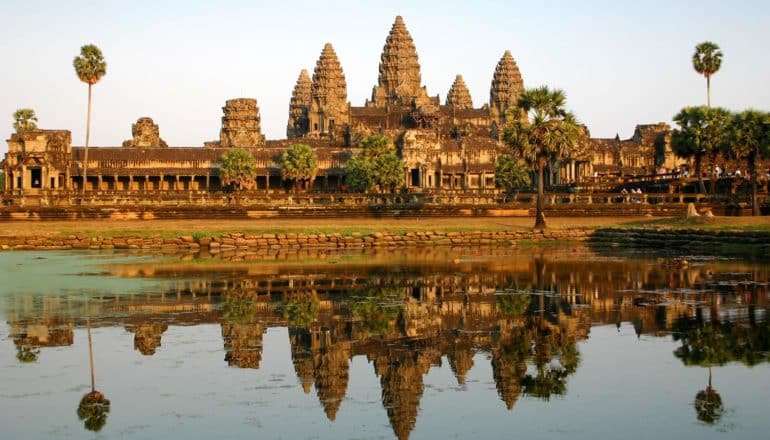
Archaeologists report that 700,000-900,000 people lived in Cambodia’s medieval Greater Angkor region.
The sprawling tropical city, which covered 3,000 square kilometers (1,158 square miles), thrived from the 9th to the 15th centuries before being abandoned, possibly due to climate change.
The paper, which combines more than 30 years of data with recent airborne lidar sensing, appears in the journal Science Advances.
Knowing the population and how it was distributed is vital for potentially helping cities now under climate pressures, says coauthor Roland Fletcher of the University of Sydney and head of the Angkor Research Program.
“We predominantly are living in giant, low-density cities around the world that are similar to Angkor, which displayed serious vulnerability to severe climate change,” Fletcher says. “We really need to know the mechanics of how Angkor worked and what people were doing to get some idea of how referable those experiences are to the risks that we face in our future.”
Cambodia’s Authority for the Protection of the Site and Management of the Region of Angkor collaborates on research in the region, which is just north of present-day Siem Reap.
The new study reveals the population distribution in the ceremonial city center, the metropolis extending outward like modern suburbia, and embankments incorporating agricultural areas. Central Angkor is home to stone religious temples, including the giant Angkor Wat temple.
Beyond central Angkor were homes and supporting structures, all made of organic materials reclaimed by the jungle, says Alison Carter, an assistant professor in the University of Oregon anthropology department. She has conducted fine-grain archaeological fieldwork in Cambodia since 2005.
Co-lead author Sarah Klassen used machine learning to merge data from historical archives and maps with lidar details obtained in 2012 and 2015 in a project led by coauthor Damian Evans of the French Institute of Asian Studies.
Lidar reveals the landscape
Lidar, which is short for light detection and ranging, is done by sending laser pulses groundward from aircraft. It captures ground details by ignoring clutter such as forests.
Lidar documented and mapped 20,000 features previously unseen, adding to a database of 5,000 locations, says Klassen, a postdoctoral researcher at the University of Leiden.
“When you are on the ground in the main parts of the city center it is quite forested,” Carter says. “As you walk around you can tell there is something in the landscape around you, but you cannot see anything clearly. Lidar gave us a beautiful grid of mounds and depressions, which we think were little ponds.”
As initial lidar images were transmitted, researchers at the Angkor field station stayed up into the early morning hours to watch, Fletcher says.
“It was absolutely fabulous,” he says. “We had earlier radar data, but the amount of new information was staggering, especially because the lidar images captured the entire region in great detail.”
The new data have been organized into different periods of Angkor’s growth, particularly in the lifetimes of kings who were most influential to infrastructure changes, says Carter, who leads the University of Oregon’s Southeast Asian Archaeology Lab.
Lidar showed where houses built on mounds and elevated on posts had stood. Those houses likely averaged five people, Carter says. That figure was extrapolated to arrive at the region’s total population.
“We looked at the growth of the city of Angkor over time,” she says. “We found that different parts of the city grew in different ways. The way we think about population growth in cities and suburbs today is probably the same for Angkor.”
Angkor’s population and cities today
The study’s findings enhance the “comparative understanding of premodern urbanism,” says coauthor Miriam T. Stark, director of the Center for Southeast Asian Studies at the University of Hawaii at Manoa.
“Studying Angkor’s population is important for envisioning the future’s urbanism with respect to global climate change,” Stark says. “Angkor was a tropical city that persisted through centuries of political and climatic volatility. Tracking its history and tipping point could help urban planners understand some kinds of constraints that face increasing numbers of the world’s cities.”
Klassen had applied machine learning to Angkor data in a 2018 study.
“In this new paper,” she says, “we introduced statistical learning paradigms and our archaeological case study and dataset. We then explored four classical mathematical approaches to find statistically significant predictors to date temples built in different locations in the region.”
That led to a historical model for temples built between the modern-era years of 821-1149 CE within an absolute average error of 49-66 years. Periods of growth covered in the new study occurred between the years 770 and 1300.
“This was critical for our study, because it allowed us to see how the metropolitan area developed in comparison to the civic-ceremonial centers,” Klassen says. “It also allowed us to estimate populations connected to the temples and see how those population changed over time.”
Source: University of Oregon
The post Lidar and maps reveal population of ancient Angkor appeared first on Futurity.
from Futurity https://ift.tt/33RduWm
No comments:
Post a Comment